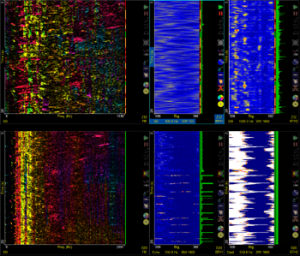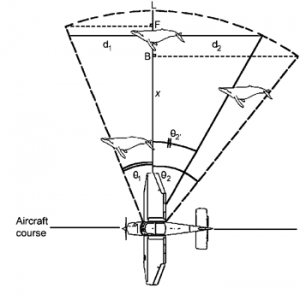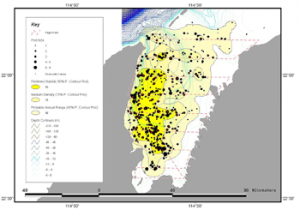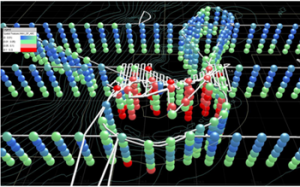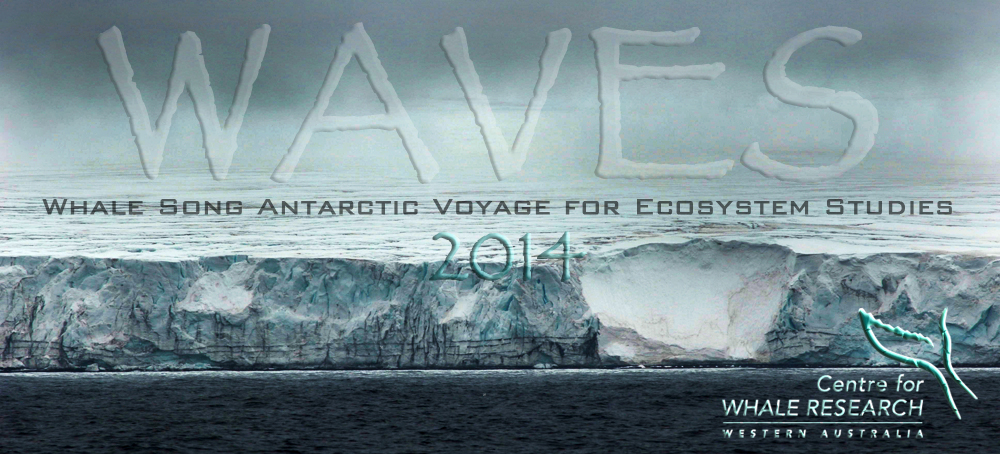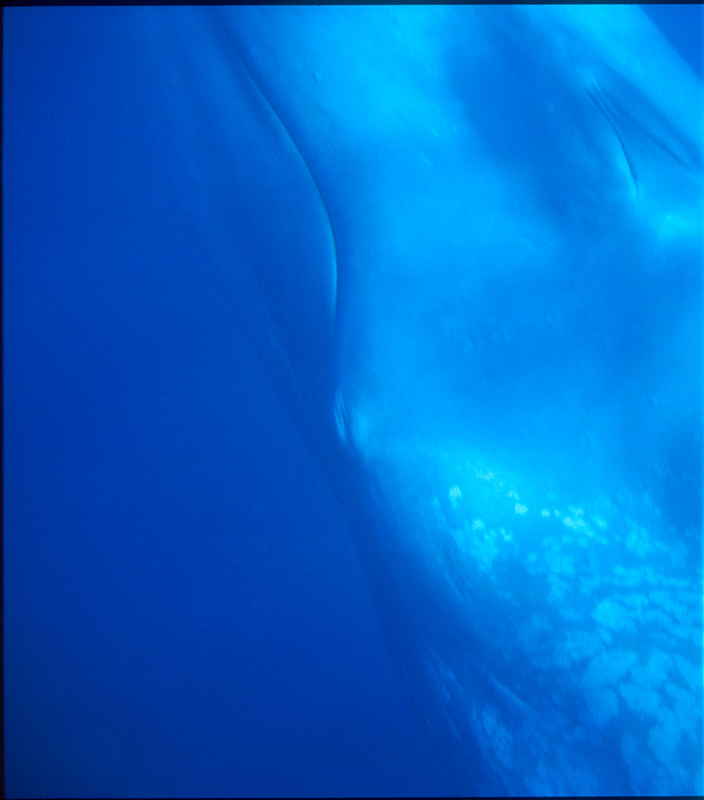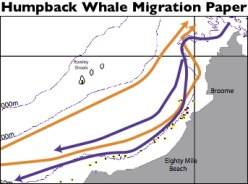Southern Hemisphere Blue Whale Population Census
Status: Funding Deficient
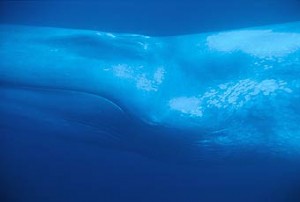
After 50 years of protection why aren’t these magnificent animals recovering? Help us find out why. Photo by Micheline Jenner
Goal: Monitor global ocean health through understanding key top predators’ population health
Description: A two pronged study approach will be undertaken to examine the population health of Antarctic blue whales and their close relative, the pygmy blue whale which are excellent indicators of ocean health due to their direct reliance on krill which form the largest primary food link for all oceanic organisms . Research studies incorporating the latest acoustic and telemetry research techniques in Antarctic feeding areas and equatorial breeding areas are expected to provide global environmental management agencies with data to identify critical blue whale habitats for the purpose of future protection. It is likely that these critical habitats are currently not adequately protected which is why this iconic species has not recovered despite over 50 years of protection from commercial whaling. This is one of the worlds greatest scientific mysteries – why have these giant, globe travelling leviathons not been able to recover? What is this telling us about the health of our planet? Its time to answer these questions.
In a recent conversation, Curt Jenner was asked “What will you do with the information once you collect it?” Read Curts’ response here.
Ambient Noise Census of Australian Waters
Status: Currently Underway
Goal: Set benchmark for ambient noise around Australia from which to judge future changes
Description: CWR has expanded its research capabilities and is targeting acoustic techniques to better understand the marine environment throughout which Humpback and other whale species migrate off the west coast of Australia, to and from their main feeding grounds near Antarctica.
As part of system performance testing activities with the Australian Defence Department, the Centre recently conducted an Acoustic Profile between Fremantle and Darwin covering 1985 nautical miles on board the Research Vessel Whale Song, during 11 continuous survey days. The main objective of this project was to explore geographical patterns in ocean ambient noise from Fremantle to Darwin according to latitude, and identify/characterise areas of increased noise levels over a short time period.
This is the first acoustic snapshot of a large area of the Australian coast. This acoustic profile included over 56 hours of listening effort where environmental (i.e. surf, storms, and earthquakes), anthropogenic (i.e. marine traffic) and biological sources (i.e. fish, crustaceans, whale calls) were recorded. As part of our data validation we : 1) characterise the local environment to understand sound propagation throughout our study area, 2) collate information regarding anthropogenic sound sources, including ship traffic (donated by exactEarth), and 3) compare the biological sound component of our recordings to the 57 hours of visual surveys conducted along transect.
Preliminary results have revealed that several species of whales and dolphins utilise the resources along the west coast of Australia, and that most of these species were concentrated mostly along the Ningaloo Reef, which covers an area of ~260km in length close to the mainland. The northern end of the Ningaloo Reef is situated at the tip of North West Cape which forms Exmouth Gulf, recognised as a significant resting area for southbound humpback whales migrating between their Kimberley calving grounds and the Antarctic. Some of the species sighted included humpback whales, minke whales, Cuviers beaked whales, Brydes whales, bottlenose dolphins, common dolphins, spinner dolphins, striped dolphins, false killer whales and dwarf spinner dolphins.
This new research will help us understand underwater sound pressure levels in areas of variable marine traffic and high biodiversity, and complement past, current and future research exploring the potential impact of increasing ocean noise on marine wildlife.
Monitoring Population Dynamics for Stock D Humpback Whales
Status: Funding deficient
Goal: Establishment of the carrying capacity of Stock D through the detection of a decrease in population size
Description: The detection of the natural decrease in humpback whale population size associated with the WA population reaching carrying capacity is a vital need for managers controlling the increase in human activities in areas traditionally used only by humpback whales. Rates of human caused mortality thru entanglement and ship strikes, as well as natural mortality such as caused by killer whale predation, particularly on new calf recruits, need to be considered and better understood.
A three component approach will be taken.
It is anticipated that CWR’s long running aerial survey program off the Ningaloo coast will be the first component, and will address population growth measurements needs, however the apparent increase in both predation and entanglement rates requires further, and an alternate means of, investigation.
As a second proactive component, CWR will seek technical assistance to develop a remotely activated fishing float system in collaboration with Western Australian state fisheries and wildlife management agencies to assist cray fishermen with the growing number of whale and ship entanglements. The base concept is a float and rope that is stored in the pot on the sea floor, instead of the water column, and can be remotely released by a fisherman using a specific acoustic signal. The system benefits fishermen, managers, shipping and most importantly the recovering humpback whale population.
The third component investigates the apparent increase in killer whale predation on new born humpback whale calves, particularly at Ningaloo Reef. Preliminary evidence suggests the same killer whale pod targets the young calves each season. It remains unknown why increasing numbers of calves are being born at high latitudes (ie, not in the Kimberley) so that this predation is possible. Given increasing calving rates in deep unprotected waters, will killer whale populations also increase and help to create a false assessment of carrying capacity for the humpback whales in this population. Do human activities on the NW Shelf of Western Australia lie at the root of this issue and act to impede pregnant females’ access to the calving grounds, therefore causing calves to be born in unprotected waters?
Identifying Critical Cetacean Habitats for Humpback Whales (Megaptera novaeangliae) off the Northwest Coast of Australia
Status: Currently Underway
Goal: Identify new critical habitats for the purpose of conservation for humpback whales in Western Australian waters as their population returns to pre whaling levels
Description: The WA population of humpback whales is growing quickly, with numbers reportedly increasing by at least 10% every year. At the same time, the WA coastline is becoming increasing developed for residential and industrial purposes. It is therefore important to manage the co-use of ocean space between humans and whales, as the demand for space from both sides continue to increase. This study will investigate the space requirement of whales while using resting areas, and the implications to future space use with an expanding population. Furthermore, the energetic modeling will provide a new approach in assessing the importance of a habitat to a population, providing a quantitative measure of impact under scenarios of disturbance.
Predictive models of mobile oceanic predator (MOP) hotspots in the Eastern Indian Ocean
Status: Currently Underway
Goal: Identify hot spots for cetaceans and other predators in previously unexplored deep water areas and then develop a predictive modelling tool to aid in future prioritisation of research and conservation.
Description: In recent years, rarefying resources on land and a rapidly growing world population have spurred the need for an increasingly greater share of goods and services to be sourced from the seas. This has led to flourishing demands for both ocean space and access. However, no strategic plan for the spatial usage and sharing of the Indian Ocean currently exists, and the lack of such a framework triggers recurring co-use conflicts between stakeholders and marine wildlife (e.g. bycatch, competition for food, vessel strikes). As numerous biologically, economically and culturally valuable populations of marine predators have been reduced to dangerously low levels, serious concerns have arisen regarding the ecological and societal footprints of a range of recreational, industrial and commercial fishing activities. This study will provide critically needed information on the mechanistic drivers behind wildlife aggregations, and generate a robust tool to assist marine spatial planning in forecasting areas where wildlife and human interests may overlap.

